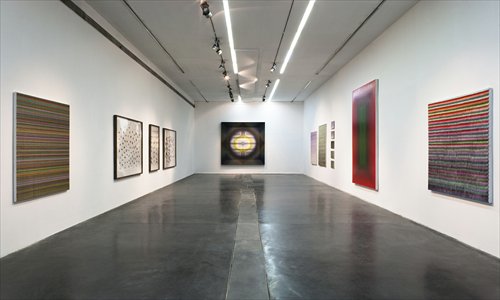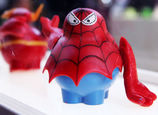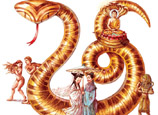
 |
| Inside the ON|OFF exhibit, on display at UCCA through April 14 (GT Phot/ Courtesy of UCCA) |
"I can't see it," would be the high-pitched vocal conclusion of a mid-'90s prepubescent schoolboy who just couldn't see what they were meant to be seeing in a Magic Eye - that series of books featuring auto-ster-eograms that allow some people to see 3D images by concentrating on specific 2D patterns on the page.
"What is it supposed to be?" the squeaky voice would enquire. Actually, it's supposed to be a boat, a spaceship, a car or a hot air balloon. But it doesn't matter what it is, little Jimmy. The point is you can't see it and we all can.
One look at local artist Xie Molin's mechanically produced and patterned "visual objects" and one can't be blamed for attempting to cheapen the artist's efforts by looking for the inanimate 3D object within the 2D forms he presents on canvas.
Xie's work, part of 50 commissioned works by 50 Chinese artists born after the death of Chairman Mao in 1976 are currently on display at the Ullens Center for Contemporary Art (UCCA) until April 14 at the 798 Art Zone, Chaoyang district.
The exhibition, called ON|OFF China's Young Artists in Concept and Practice, has been running since mid-January. ON|OFF is jointly curated by independent curator and art critic Bao Dong and senior editor at LEAP magazine Sun Dongdong. Keeping within the rules of the exhibition, both were also born after 1976.
"The ON|OFF title originates from a computer term," says Bao, originally from Anhui Province. "Our government set up a firewall in order to block us from visiting foreign websites. But there is software that allows us to hurdle it, which [in Chinese] is also known as the 'turn on/turn off the firewall.'"
Bao says the great firewall of China resembles tyranny or confinement. However, the focus of the exhibition is to emphasize "the coexistence of confinement and freedom," he says. "The focus is the shift from on to off. It is the middle point [between on and off] that we want to display."
For contributing Beijing artist Shi Wanwan (a 1981 baby) from Jiangsu Province, whose work An Istanbul Painter is featured, the exhibition is primarily for those born after 1976 - the year when the decade of the Cultural Revolution(1966-76) ended.
"There is no specific theme for this exhibition. But [the organizers] want us to show our individuality, novelty and our concept of art. To show how differently we think and act from our counterparts before 1976," Shi said.
Shi's main concern is that the artists and artist groups involved in ON|OFF do not overuse a revolutionary or historical theme.
"We don't contain too many Chinese characters. We are more international, more open [and] subjective. We are much more self-conscious and diversified," Shi said.
But the ability to be self-conscious, subjective and international requires at least some kind of funding, if art is to be art for its own sake. One can't help thinking that some of these young artists' historical contemporaries pre-1976 never had the opportunity to express themselves in quite the same way.
For Xie, whose works Ji NO.4 and Inconsistent Output NO.6 are on display, art was never a professional territory for his family. However, there was always love and financial support to foster a burgeoning artistic talent.
"[My family] took me to painting class and paid my tuition when I was 7," says the man who cites Damien Hirst, Jackson Pollock, David Hockney and Bridget Riley as primary influences among many other non-Chinese artists.
In 2003, Xie graduated from the Central Academy of Fine Arts in Beijing with a major in mural design before attending the Edinburgh College of Art in Scotland, where he completed a master's degree in painting.
"You can feel my work through its texture, through the environment, or through the material," Xie concludes of his work. "But I don't want to spoil everything by telling you. Come to the show and see my work with your own eyes. Everything is there in my work."
I think I see a 3D image of a revolutionary scene somewhere in there. But the point is, can you?
















 A 9-year-old girl and her father are traveling to 31 major cities across China on foot and by hitchhiking.
A 9-year-old girl and her father are traveling to 31 major cities across China on foot and by hitchhiking.


![]()
